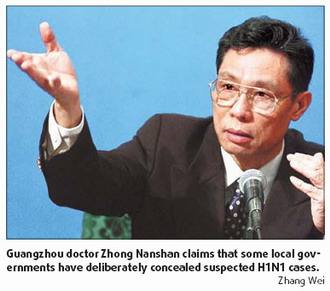Local officials urged to tell A/H1N1 truth
The Ministry of Health (MOH) Thursday vowed to punish officials who underreport the A/H1N1 flu pandemic following criticism from a prominent medical expert who cast doubt on China's official death toll from the disease.
 Some medical experts have wondered aloud whether the country's A/H1N1 data matches the reality. They pointed to limitations in medical capacity and the fact that hospitals are not testing everyone with flu symptoms for A/H1N1 as reasons why the outbreak may have been underreported.
Some medical experts have wondered aloud whether the country's A/H1N1 data matches the reality. They pointed to limitations in medical capacity and the fact that hospitals are not testing everyone with flu symptoms for A/H1N1 as reasons why the outbreak may have been underreported.
But Zhong Nanshan, a Guangzhou-based doctor famous for his candor in exposing a cover-up of the SARS epidemic in 2003, took concerns a step further, suggesting some local governments had deliberately concealed suspected cases.
"I just don't believe that there have been 53 A/H1N1 deaths nationwide," Zhong told the Southern Metropolis Daily. He said the number could be far higher.
The MOH reported that there had been 69,160 A/H1N1 cases on the mainland as of Monday.
In the article, Zhong said some parts of the country - he would not say which parts - were not testing severe pneumonia deaths to see if they were, in fact, A/H1N1 deaths.
MOH spokesman Deng Haihua responded by saying that anyone found concealing, underreporting or delaying the reporting of details about the pandemic would be punished.
Deng also invited the public and the media to oversee the transparent and timely reporting of the A/H1N1 situation.
Vivian Tan, press officer with the World Health Organization's (WHO) Beijing office, said WHO staff are not able to say whether claims of deliberate underreporting at the local level are accurate.
"We know the MOH has been urging local health authorities to report A/H1N1 cases in a transparent way and we do not suspect deliberate underreporting from the ministry," she noted.
She suggested that the country should focus its resources on monitoring bigger trends and unusual developments, as well as treating severe cases and continuing the vaccination of as many people as possible.
Meanwhile, nine special teams of MOH officials have been sent to 12 provinces - including Hebei, Shanxi, and Qinghai - to inspect local pandemic control work, particularly the treatment of severe cases.
Feng Zijian, director of the emergency response department under the Chinese Center for Disease Prevention and Control (CDC), said that A/H1N1 cases are too plentiful to count and noted that the testing of every flu patient for A/H1N1 was not necessary.
Feng conceded that there likely have been more A/H1N1 infections and deaths nationwide than has been reported. But he criticized Zhong for his claim of a cover-up.
"China is huge and its medical resources are not evenly distributed," Feng said. "It is understandable that medical workers in some areas have failed to report the pandemic accurately."
As in many other countries, China is not able to diagnose and record every A/H1N1 case, some experts have said, noting the fact that some people with A/H1N1 could conceivably stay at home and not seek medical help.
The US Center for Disease Control estimated that the number of A/H1N1 infections in the US was 140 times the official number.
Cover-ups during the SARS epidemic reportedly led to the sackings of several top officials, including the then health minister and mayor of Beijing. More than 300 people died in that outbreak.
Going forward, Deng said the government will strengthen supervision of pandemic reporting.
Experts said that will happen if communication between the local and central health departments is improved.
As of Wednesday, more than 18.2 million people had received a free vaccination against the virus, the ministry added.
 0 Comments
0 Comments







Comments